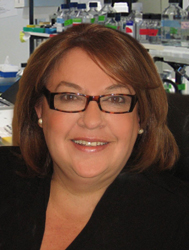Elena Posse de Chaves
Dr Elena Posse de Chaves
Professor
Education:
PhD (Hons) Biochemistry, Universidad Nacional de Tucumán, Argentina, 1992
BSc (Pharmacy), Universidad Nacional de Tucumán, Argentina, 1987 Biochemist (Professional Degree) (Hons.) Biochemistry, Universidad Nacional de Tucumán, Argentina, 1983
Teaching: PMCOL343, PMCOL344, PMCOL412, PMCOL475/575*, Neuro410
Research: Role of lipids and lipoproteins in neurodegeneration in Alzheimer's disease
Research Interests / Laboratory Techniques
The research lab of Dr. Posse de Chaves focuses on the role of lipids, in particular cholesterol and isoprenoids, and their regulation by statins in neurodegeneration. The lab uses a biochemical and cell biological approach together with functional studies in animal models. There are currently two main projects.
Regulation of Alzheimer's Disease-related mechanism by isoprenoids and protein prenylation
Alzheimer's disease (AD) is the most common type of senile dementia and one of the most serious health problems of our time for which treatments are urgently needed. In order to develop therapeutic strategies, it is crucial to understand better the events that lead to the disease. A connection between cholesterol and AD is well established. Isoprenoids are synthesized together with cholesterol by the mevalonate pathway. The Posse de Chaves lab has discovered that oligomeric amyloid beta peptide (oAβ42), which accumulates in brains of AD patients, inhibits the mevalonate pathway causing a reduction of protein prenylation. Protein prenylation is a posttranslational modification essential for normal activity of several proteins. The lab is investigating the mechanisms by which inhibition of protein prenylation contributes to AD pathology. In particular, the work concentrates on the importance of protein prenylation in autophagy and in the prion-like spreading of Aβ.
Pre-clinical studies on the effect of statins in REP-1 replacement ocular gene therapy in choroideremia
Choroideremia (CHM) is an X-linked retinal degenerative disease resulting from a lack of functional Rab Escort Protein-1 (REP-1). REP-1 is a protein which chaperons the Rab proteins to intracellular membranes during and after their prenylation. An internet-based health survey on the co-morbidities of choroideremia (CHM) patients found patients taking statins had poorer vision. Statins inhibit HMG-CoA reductase causing decrease of isoprenoid synthesis and impairment of protein prenylation. Using a mouse model of CHM, the Posse de Chaves lab is testing whether statins synergize with the decreased prenylation caused by CHM mutations and if statins hamper the effect of REP-1 replacement therapy by limiting the isoprenoid pool.
Selected Recent Publications
Amritraj A, Posse de Chaves EI, Hawkes C, Macdonald RG, Kar S (2012). Single-transmembrane domain IGF-II/M6P receptor: potential interaction with G protein and its association with cholesterol-rich membrane domains. Endocrinology. 153(10):4784-4798. PMID: 22903618.
Mohamed A, Saavedra L, Di PA, Sipione S and Posse de CE (2012). β-amyloid inhibits protein prenylation and induces cholesterol sequestration by impairing SREBP-2 cleavage. J Neurosci. 32(19):6490-6500. PMID: 22573671.
Mohamed A, Posse de Chaves E (2011). Aβ internalization by neurons and glia. Int J Alzheimer's Dis 2011:127984. PMID: 21350608.
Huxtable AG, Zwicker JD, Alvares TS, Ruangkittisakul A, Fang X, Hahn LB, Posse de Chaves E, Baker GB, Ballanyi K, Funk GD (2010). Glia contribute to the purinergic modulation of inspiratory rhythm-generating networks. J Neurosci 30(11):3947-3958. PMID: 20237265.
Posse de Chaves EP, Sipione S. (2010) Sphingolipids and gangliosides of the nervous system in membrane function and dysfunction. FEBS Lett 584(9):1748-1759. PMID: 20006608.
Aglah C, Gordon T, Posse de Chaves EI (2008). cAMP promotes neurite outgrowth and extension through protein kinase A but independently of Erk activation in cultured rat motoneurons. Neuropharmacology 55(1):8-17. PMID: 18502451.
Saavedra L, Mohamed A, Ma V, Kar S, Posse de Chaves EP (2007). Internalization of β-amyloid peptide by primary neurons in the absence of apolipoprotein E. J Biol Chem 282(49):35722-35732. PMID: 17911110.
Song MS, Saavedra L, Posse de Chaves EI (2006). Apoptosis is secondary to non-apoptotic axonal degeneration in neurons exposed to Aβ in distal axons. Neurobiol Aging. 27(9):1224-1238. PMID: 16122841.
Chung, J. et al. Endosomal-Lysosomal Cholesterol Sequestration by U18666A Differentially Regulates Amyloid Precursor Protein (APP) Metabolism in Normal and APP-Overexpressing Cells. Mol Cell Biol 38, doi:10.1128/MCB.00529-17 (2018).https://www.ncbi.nlm.nih.gov/pubmed/29530923
Mohamed, A., Smith, K. & de Chaves, E. P. in Alzheimer's Disease - Challenges for the Future (ed Prof. Inga Zerr) Ch. Chapter 7, 167- 222 (INTECH, 2015).
Posse de Chaves, E. Reciprocal regulation of cholesterol and beta amyloid at the subcellular level in Alzheimer's disease. Can J Physiol Pharmacol 90, 753-764, doi:10.1139/y2012-076 (2012).http://www.ncbi.nlm.nih.gov/pubmed/22626060
http://www.nrcresearchpress.com/doi/abs/10.1139/y2012-076?url_ver=Z39.88-2003&rfr_id=ori%3Arid%3Acrossref.org&rfr_dat=cr_pub%3Dpubmed&
http://www.nrcresearchpress.com/doi/pdfplus/10.1139/y2012-076
Mohamed, A., Saavedra, L., Di Pardo, A., Sipione, S. & Posse de Chaves, E. beta-amyloid inhibits protein prenylation and induces cholesterol sequestration by impairing SREBP-2 cleavage. J Neurosci 32, 6490-6500, doi:10.1523/JNEUROSCI.0630-12.2012 (2012).http://www.ncbi.nlm.nih.gov/pubmed/22573671
Amritraj, A., Posse de Chaves, E. I., Hawkes, C., Macdonald, R. G. & Kar, S. Single-transmembrane domain IGF-II/M6P receptor: potential interaction with G protein and its association with cholesterol-rich membrane domains. Endocrinology 153, 4784-4798, doi:10.1210/en.2012-1139 (2012).http://www.ncbi.nlm.nih.gov/pubmed/22903618